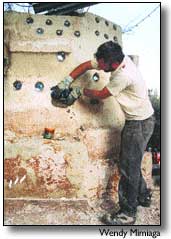Papercrete homes offer affordability
December
1, 2001
 |
| PHILIP
MIRKIN works on an addition to his papercrete home in Egnar recently.
Mirkin, who offers seminars on building homes with the alternative
method, says it is cheap, safe and easy for do-it-yourselfers. |
By
Jim Mimiaga
Journal Staff Writer
Need
to build a quality home fast and on the cheap?
Check
out an alternative building technique that combines newspaper or clay
with cement to form sturdy bricks and walls that stand up to strength
tests.
Using
either the "papercrete" or "fibred-adobe" process,
a modest 1,000 square-foot home could be built in only a few months with
$2,000 in materials, according to Philip Mirkin, an architect from Egnar
who teaches seminars on the process.
Mirkin,
40, fell in love with papercrete because of its creative possibilities
and affordability.
"It
is easy to do and dirt cheap," says Mirkin. "Ten-year-old kids
are strong enough to build a papercrete house -- it's that simple."
In
contrast, wood-frame homes typically cost between $20 and $30 per square
foot, as do straw-bale homes. Both types of construction also require
ample expertise.
The
recipe for making papercrete bricks calls for one part clay or newspaper
(or both), one part water and one part Portland cement. Combine; pour
pulp into desired forms; allow to dry. The resulting papercrete or fibredobe
brick is so strong, it exceeds the tensile strength of cement and has
proven load-bearing capacity.
"The
paper fibers lock in with the clay or cement and create a matrix of interwoven
material that's lightweight and very strong," Mirkin said, adding
that the building material will hold up for 150 years.
To
mix large quantities, Mirkin uses an innovative contraption. He fitted
a truck bed with a large container that, at the bottom, has a lawnmower
blade connected to the truck's drive train. Once the ingredients are added
to the 200-gallon mixer, the truck is driven around a bit and, presto!
-- a thick mud suitable for construction is formed.
Once
the bricks or shaped forms have dried out, which takes between one and
three weeks, they are ready to be stacked to form walls, arches, doorways
and roofs.
The
same mud is used for mortar and as a plaster after the wall is up. The
structure can then be sealed with linseed oil or paint.
The
result is an adobe-style house, but without the high cost. Advocates say
papercrete has advantages over straw-bale construction because the papercrete
walls are load-bearing, more versatile and less labor-intensive.
Other
attributes are that it is fire-proof, does not use toxic materials, encourages
conservation and recycling, saves trees and has a high insulation value.
Because it is so light, building with papercrete does not require a foundation.
Wet weather does not harm the material, and roofs can hold up to 20 feet
of snow.
The
method has been around since the 1920s but is just now gaining significant
acceptance. Mirkin expects papercrete to become as mainstream as strawbale
construction, and says the federal government is about to approve it as
code-worthy.
The
town of Crestone, Colo. has adopted the technique as an acceptable alternative
that meets building codes. There are some 20 papercrete homes in Crestone.
Curved
walls and dome ceilings are easily built using the material, Mirkin said.
He is experimenting with red willow woven into the ceiling as a natural
highlight.
And,
amazingly, a wall built with this material has such strength that windows
can be cut in by using a chainsaw, Mirkin explained.
"It
is very free-form, so say you want a window shaped as a half-moon, then
get out the chain or jig-saw and cut away," he said. "It's almost
impossible to screw up using this material."
Mirkin
is offering several seminars this winter.
One
is today from 11 a.m. to 4:30 p.m. at Mirkin's place near Egnar. A workshop
follows on Sunday, Dec. 2, beginning at 11:30 a.m. Cost is $35 for the
seminar and $20 for the workshop.
Two
others will be held in Durango on Dec. 8 and 9. That one costs $50 total.
Call 677-3600 to register and for directions. Space is limited.
Mirkin
can also be reached via e-mail at
Copyright
© 2001 the Cortez Journal. All rights reserved. This article reproduced
here under the fair use guidelines as codified in Section 107 of the Copyright
Act of 1976.
The original form of this article appeared in the Cortez
Journal Online.
|

